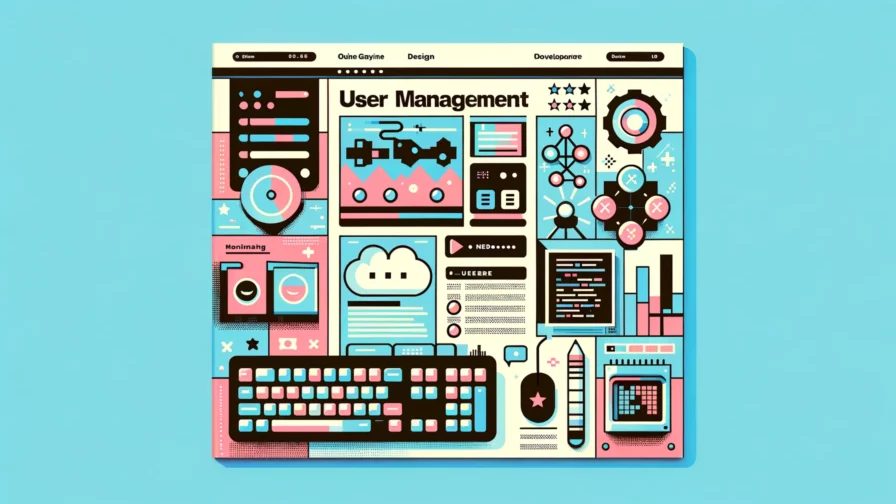
What Is User Management?
User management refers to the processes and methodologies employed to control who has access to an application or system. It includes tasks such as creating user accounts, assigning roles and permissions, managing passwords and other security credentials, auditing user activities, and ensuring compliance with relevant policies and regulations.
The main goal of user management is to ensure that only authorized individuals can access the application and that they can only perform actions within their designated roles. For instance, a sales representative in a CRM application should not be able to perform system administration tasks. Besides, user management also aims to enhance the user experience by providing features such as password recovery, account personalization, and user activity tracking.
User management is not just about controlling access. It also plays a significant role in data security. By implementing stringent user management practices, businesses can prevent unauthorized access to sensitive data, thereby reducing the risk of data breaches. Furthermore, it helps in complying with various data protection laws and regulations.
Technologies for User Management for Your Applications
The complexity and demand for more secure and user-friendly applications have led to the development of several user management technologies. These technologies provide robust solutions for managing user identities and access to applications. Let’s explore some of these technologies.
Identity and Access Management (IAM) systems
IAM systems are a set of technologies and policies used to manage digital identities and control their access to resources. They provide a unified view of user access across the entire organization, helping businesses improve security, meet compliance requirements, and enhance operational efficiency.
IAM systems work by establishing, managing, and enforcing rules about who gets access to which resources. They include functionalities for user registration, authentication, authorization, and auditing. With IAM systems, businesses can implement role-based access control (RBAC), where users are granted access based on their roles within the organization.
Furthermore, IAM systems help in automating essential user management tasks such as provisioning and de-provisioning of user accounts, password management, and user activity logging. This automation not only saves time and resources but also eliminates the risk of human error, making the system more secure.
Single Sign-On (SSO) and Social Login
SSO is a user authentication service that allows a user to use one set of login credentials to access multiple applications. The main advantage of SSO is that it simplifies the authentication process for users, thereby enhancing their experience. They don’t need to remember multiple usernames and passwords, reducing the risk of password fatigue and the consequent security risks.
Social logins are a special type of SSO that allows users to sign into a third-party application using their existing social network credentials. This not only simplifies the sign-in process but also helps businesses gather valuable user information from social networks, which can simplify signup and help personalize the user experience.
OAuth
OAuth (Open Authorization) is an open standard for token-based authentication and authorization. It allows third-party applications to access user data from a service provider, without sharing the user’s credentials.
OAuth works by providing the application with an access token (instead of the user’s credentials) that authorizes specific account information to be shared. The application can then use this token to access the user’s data from the service provider. OAuth is widely used in social login mechanisms where users can log into applications using their social network accounts.
OpenID Connect
OpenID Connect is a simple identity layer on top of the OAuth 2.0 protocol. It allows clients to verify the identity of the end-user based on the authentication performed by an authorization server.
OpenID Connect provides a standard way for applications to obtain and handle identity information. It is used in scenarios where an application needs to authenticate the user and get basic profile information. Unlike OAuth, which is designed for authorization, OpenID Connect is specifically designed for authentication.
JWT
JWT (JSON Web Token) is a compact, URL-safe means of representing claims to be transferred between two parties. It provides a way for applications to share security information in a reliable way. JWT is used in identity and access management to create access tokens that can be used to authenticate users and transmit information between parties.
JWTs are self-contained, meaning they carry all the necessary information within themselves. This eliminates the need to query the database more than once after the user is logged in, thereby improving the performance of the application.
Best Practices for Effective User Management
Now that we’re familiar with the fundamental technologies powering user management, let’s review best practices that will help you build effective user management into your applications.
Simplify User Registration and Account Management
Simplifying the user registration and account management process is crucial in enhancing the user experience. A complex or confusing registration process can deter potential users and negatively impact your application’s growth.
This involves designing a user-friendly registration interface, providing clear instructions, and minimizing the amount of information required from users. It also involves implementing simple and efficient account management processes that allow users to easily update their information, change their passwords, or delete their accounts.
Moreover, it is also essential to provide robust customer support to assist users with any issues or questions they might have regarding the registration or account management process.
Align Authorization Systems with User Roles and Permissions
The first step in effective user management is designing a robust authorization system that aligns with user roles and permissions. This involves defining the different user roles within your application and assigning specific permissions to each role.
For instance, an administrator may have full access to all system resources, while a regular user might only have access to specific sections of the application. This differentiation is crucial in ensuring that users only access resources that are necessary for their roles, enhancing system security and efficiency.
Moreover, it is also essential to implement a dynamic authorization system that can accommodate changes in user roles and permissions. For instance, if a user gets promoted to a managerial position, they might need additional permissions to access more resources. A dynamic authorization system should be able to accommodate such changes seamlessly, without compromising system security or user experience.
Adhere to Data Protection Regulations
Data protection is another crucial aspect of user management. With the increasing prevalence of data breaches and cyber-attacks, it is more important than ever to ensure that your application adheres to all relevant data protection regulations.
This involves implementing robust security measures like encryption, secure data storage, and regular security audits. It also involves ensuring that your application complies with regulations like the General Data Protection Regulation (GDPR) and the California Consumer Privacy Act (CCPA), which provide strict guidelines on how user data should be handled.
Moreover, it is also crucial to educate your users about their data rights and how their data is being used. This can be done through clear and concise privacy policies and regular communication with your users.
Implement Password Security Policies
Password security is another crucial aspect of user management. Weak or compromised passwords are one of the most common causes of data breaches, making it imperative for applications to implement robust password security policies.
This can involve enforcing strong password policies that require users to create complex and unique passwords. It can also involve implementing additional security measures like two-factor authentication, which provides an extra layer of security by requiring users to verify their identities through a second device or method.
Moreover, it is also essential to educate your users about the importance of password security. This can involve providing guidelines on creating strong passwords and regular reminders to change their passwords.
Ensure Least Privilege Access
Least privilege access is a principle in information security that suggests that users should only be granted the minimum permissions necessary to perform their work. This approach minimizes the potential damage that can result from error, unauthorized access, or malicious intent.
In practice, ensuring least privilege access involves careful assessment and management of user roles and permissions. For instance, a regular user should not have the same system access as a system administrator. Similarly, a temporary employee or contractor should have restricted access limited to the duration of their assignment.
This approach requires regular reviews and updates of user roles and permissions, as well as robust monitoring and auditing systems to detect and respond to potential security breaches.
Design User Management for Scale
As your application grows, your user management system should be able to scale with it. This involves designing a system that can handle an increasing number of users and accommodate changes in user roles and permissions.
This can involve implementing cloud-based user management systems, which provide scalability and flexibility. It can also involve regular system audits and updates to ensure that your user management system remains efficient and secure as your application grows.
In conclusion, effective user management for your applications involves a combination of robust authorization systems, data protection measures, password security policies, least privilege access, simplified registration and account management processes, scalability, and regular updates and maintenance. By adhering to these best practices, you can ensure that your application remains secure, efficient, and user-friendly.
